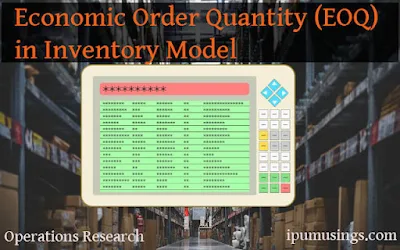Operations Research: Economic Order Quantity (EOQ) in Inventory Model #InevntoryManagment #ipumusings #operationsresearch #production #bba #mba
Operations Research: Economic Order Quantity (EOQ) in Inventory Model
The concept of economic ordering quantity was first developed by F. Harris in 1916.
The concept is that management is con fronted with a set of opposing costs - as the lot size (q) increases, the carrying charges (C1) will increase while the ordering costs (C3) will decrease. On the other hand, as the lot size (q) decreases, the carrying cost (C1) will decrease but the ordering costs will increase (assuming that only minor deviations from these trends may occur).
Thus, economic ordering quantity (EOQ) is that size of order which minimizes total annual (or other time period as determined by individual firms) cost of carrying inventory and cost of ordering under the assumed conditions of certainty and that annual demands are known.
There are two ways EOQ can be determined:
1. Trial and Error Method
2. Graphical Method
Determination of EOQ by Trial and Error Method
Step 1. Select a number of possible lot sizes to purchase.
Step 2. Determine total cost for each lot size chosen.
Step 3. Finally, select the ordering quantity which minimizes total cost.
Following illustrative example will make the procedure clear.
For example, suppose annual demand (D) equals 8000 units, ordering cost (C3) per order is ₹ 12.50, the carrying cost of average inventory is 20% per year, and the cost per unit is ₹ 1.00. The following table is computed.
| No. of Orders Per Year |
Lot Size |
Average Inventory |
Carrying Charges 20% Per Year |
Ordering Costs ₹ 12.50 Per Order |
Total Cost Per Year (₹) |
|---|---|---|---|---|---|
| 1 2 4 ->8 12 16 32 |
8,000 4,000 2,000 1,000 667 500 50 |
4,000 2,000 1,000 500 333 250 125 |
₹.800.00 400.00 200.00 100.00 66.00 50.00 25.00 |
₹.12.50 25.00 50.00 100.00 150.00 200.00 400.00 |
₹.812.50 425.00 250.00 200.00 216.00 250.00 425.00 |
This table indicates that an order size of 1000 units will give us the lowest total cost among all the seven alternatives calculated in the table. Also, it is important to note here that this minimum total cost occurs when
Disadvantage of Trial and Error Method.
In above example we were fortunate enough in finding the lowest possible cost. But, suppose the computation for 8 orders per year had not been made. Then, we could choose only among the six remaining alternatives for the lowest cost solution. This imposes a serious limitation of this method. So, a relatively large number of alternatives must be computed before the best possible least cost solution is obtained. In this situation, the graphical method may be advantageous.
In the next post we'll discuss about the graphical method.
👉See Also:
Different OR Models
Linear Programming - Formulation Technique (Q & A)
Linear Programming - Finding Graphical Solution
Costs Associated with Inventory Problems




